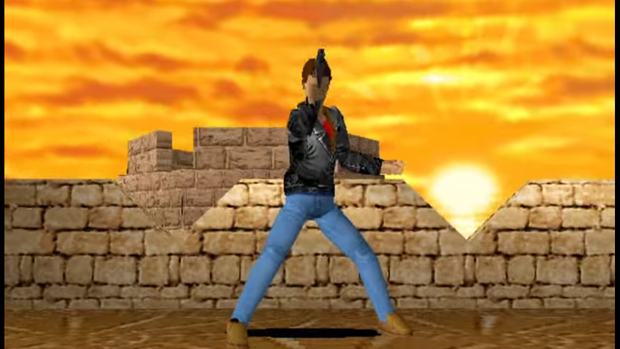Why I Love: The Time Crisis foot pedal 20 years later
Time Crisis looks bizarre when viewed with 2016 eyes. Imagine the teenager accidentally stumbling on Namco's 20 year old arcade cabinet in some sticky-floored, college town movie theater. It’s Friday night, that midnight screening of Deadpool’s sold out, and here’s this ancient arcade game, its blocky characters diving slowly behind cover like gun-toting papercraft dummies carried by a stiff breeze. It has the graphical fidelity of a 2010 iPhone game and what looks like the stiffest cover system this side of a game jam remake of Gears of War. Why would anyone ever want to play this monstrosity now? But I tell you, if that kid popped a stray quarter in the machine, picked up Time Crisis’ heavy light gun, and stomped down that weird steel pedal at the base of the machine to jump out of cover, he’d get it. Time Crisis rules and it has everything to do with the tactile pleasure of stepping on that pressure-sensitive panel.
Light gun shooters--all but extinct arcade and console games that flashed light on CRT screens to detect where you were pointing a gun or laser or whatever the hell the game said it was--had toyed with physical feedback before Time Crisis, but Namco’s game added two distinct layers. First was the kick of the “Guncon” controller, which gave the type of exaggerated jolt when you squeeze the trigger I imagine the guns in anime like Ghost in the Shell have. Second was the cover panel. Counterintuitively, the panel doesn’t make you hide behind something for protection from the weirdly sluggish bullets fired by President’s daughter-kidnapping terrorists. When you press down, you actually leap out to shoot. Release the pedal and you rush behind cover again automatically.

The pedal brings an intense physicality to Time Crisis. When you start Time Crisis, a cruelly short timer automatically starts counting down. You have seconds before it’s game over. The only way to add time to the clock is to act, hitting the pedal to jump out and shoot terrorists or save civilians. The better you do, the more time you get, but the real challenge is in being as economical as possible when leaving cover, making sure you know where everything is before making yourself vulnerable. Even more so than pulling the trigger on the gun, that step adds bodily intent to the type of decision that usually just exists in your head. Having the pedal actually force you to take cover seems like a more natural physical corollary. Slam my foot, hide behind a stone pillar while some goon in blue fatigues (why blue?!) takes pot shots at me. But by tying the pedal to jumping from cover, the physical element isn’t about immersive realism so much as making your decisions feel dramatic.
Even after many, many sequels and home ports for Time Crisis; even after a decade of cover-based shooters that have us clinging to polygonal walls by habit; even after all the graphical advancements that come from two decades of game evolution, Time Crisis has a feel all its own. Does the pedal look strange in the eyes of the player, ensconced in modernity and free of nostalgia? Almost certainly. But it’s still powerful to step on it, for the first or hundredth time.
Sign up to the GamesRadar+ Newsletter
Weekly digests, tales from the communities you love, and more



